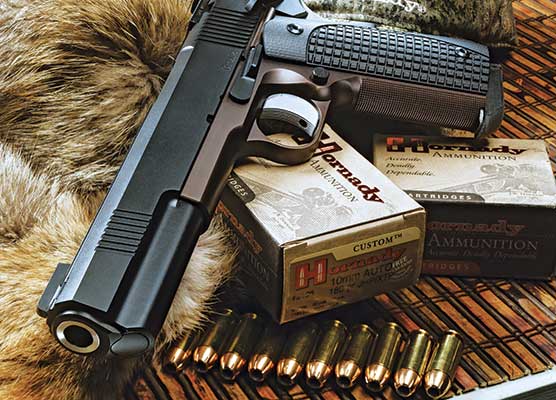Red Dots For Carry?
Optical sights compact enough for
concealed carry have been with us for a
while now. How are they working out?
I remember back in the ’80’s when Brian Enos, shooting a Frank Glenn custom S&W .38 revolver with an Aimpoint on top, stunned us all by winning the Bianchi Cup, the first to do so with other than iron sights. Not too long after, Jerry “The Burner” Barnhart won the IPSC Nationals with a red dot atop his comped 1911. Trends began then and there in both sports.
Today, of course, the red dot is the go-to combat optic for the AR-15 rifle, and there have been a new generation of optic-ready pistol slides from FN, GLOCK, S&W, et al. Today’s red-dot optical sights are small enough that, while they’re not “concealment” gear per se, they’re certainly “concealable.”
They come with many names: MOS (Modular Optical System), RDS (Red Dot Sights) and now RMR (Ruggedized Miniature Reflex, which is exclusive to its manufacturer, Trijicon). RMR is a name so often used for such sights in general it’s in danger of becoming a generic term. Any concept for which there are already two or three acronyms is a concept probably here to stay.
The bull’s-eye pistol competitors discovered optics extend the shooting life of gunners with aging eyes and raised scores of younger contestants long before the tactical/practical crowd. Cops were concerned with size and bulk, concealed carriers more so, and both were skeptical of reliability and durability. The size and bulk matter has improved dramatically with today’s generation, including the aforementioned RMR, the Leupold DeltaPoint and the FastFire from Burris. Years of combat in “the sandbox” proved the worth of the red dot on rifles, but there has been no analogous institutional police or military experience with them on handguns.
I don’t even know of a shooting case in which one was mounted on sidearm on either side of the fight. (If you know of such, dear reader, please send a link to me in care of this magazine.) Thus, testing seems to be pretty much restricted to durability in long-term daily carry and range/match use. There is pressure on IDPA (International Defensive Pistol Association), the concealed carry sport, to create a street optics competition division. USPSA, the United States Practical Shooting Association, has already announced a Carry Optics division.
Profiles & Adaptation
I’m seeing three clusters of likely users with two on opposite ends of the generational bell curve: Folks with assorted visual focus problems, aging shooters with aging eyes, and the young techno-oriented Millennials my friend Michael Bane calls “Shooter Gen 2.0.” I tried the red dots when they came out, including one Bianchi Cup (late ’80’s, a then-state of the art Tasco on an Andy Cannon Custom S&W 686) and could just never learn to acquire them as quickly as I could conventional sights. I figured I was simply an old dog who couldn’t learn new tricks. Turns out, I’m not the only one.
Karl Rehn’s Research
Karl Rehn, Grandmaster shooter and trainer has done the most thorough research I know of comparing carry optics with other defensive handgun sighting systems. His study encompassed “119 participants from 19- to 76-year-old males and females, skill levels from novice to Grandmaster/instructor.” Smith & Wesson M&P CORE 9mm pistols were the test guns, and they were variously shot with iron sights (solid black rear, fiber optic front), Streamlight TLR-2G light/laser and Trijicon RMR with 6.5 MOA red dot––shooters tried the latter both with and without the iron sights.
I would have thought us geezers who participated might do our best with the red dots, but I would have been wrong. Karl found, “Older shooters did worse with all sights other than iron sights.” He also determined most shooters were faster with the red dot optics if iron sights were in place, probably because eyes habituated to finding front sights can use such a visual reference to “find the dot” faster. I’d concur with that. The Rehn study found hits were faster with iron sights than carry optics at 5 or 10 yards. Still, a preponderance of red dot shooters seem to find themselves much more accurate with the optic at longer distances than with irons.
Technology progresses. Karl expects the Carry Optics Division in USPSA to yield a rich mine of data. He has noted that in Steel Challenge matches contestants tend to be 10 to 15 percent faster with red dots, but the ones they’re using are competition optics usually mounted to the frame, not really suited to everyday carry guns. His full research paper has not yet been published, and when it is, we’ll notify you here.






